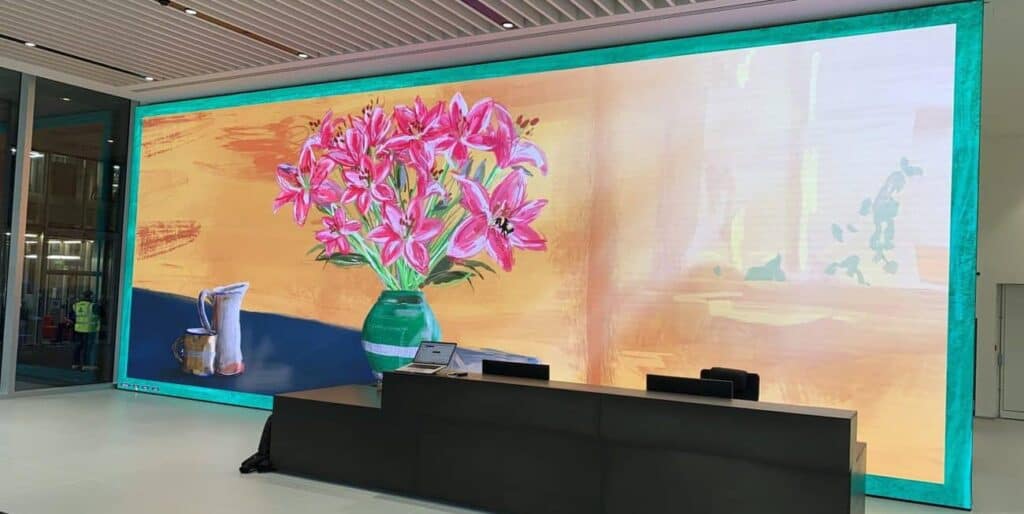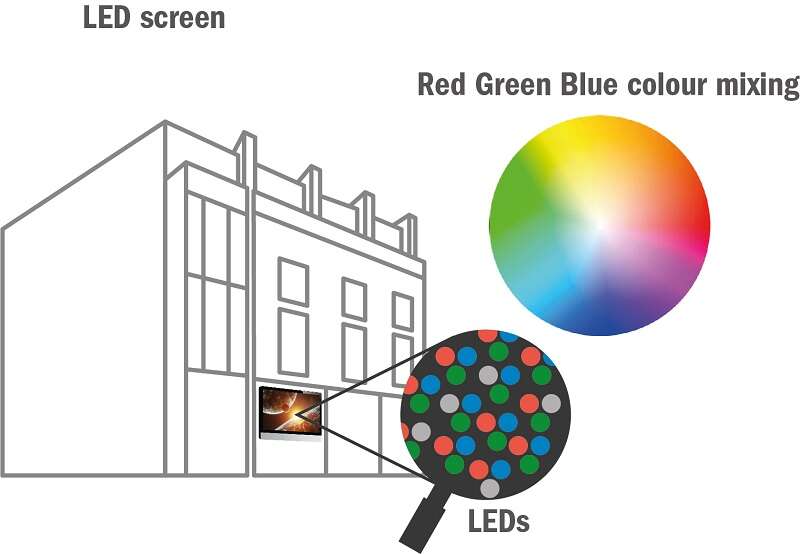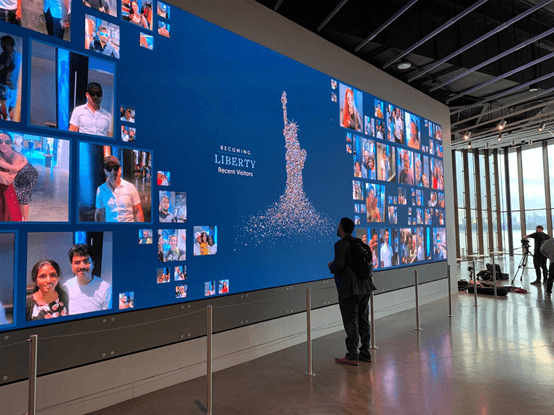Good Info On Deciding On Outdoor Fixed Led Display
Good Info On Deciding On Outdoor Fixed Led Display
Blog Article
What Is The Importance Of Pixel Pitch And Resolution In The Research Of Led Displays?
In the research of LED displays the resolution and size of the pixels are very important. Both of these factors directly affect the clarity and detail of the display, and also the overall experience. They are crucial due to these reasons:
1. Image Quality
Pixel Pitch: Pixel pitch is the distance between the center of one LED's pixel and the middle of the next. A lower Pixel Pitch signifies that the pixels are closer which leads to better resolution and a greater the density of pixel. This directly translates into crisper, more detailed pictures that are particularly important for pictures that have high-quality text or fine details.
Resolution: The resolution refers to the amount of pixels on the display. It's typically expressed as width x height, e.g. 1920x1080. The greater the resolution, the more precise the display will appear. It also makes for a more immersive experience. This is especially important when you are viewing screens with large sizes.
2. Viewing Distance
Pixel pitch is directly related to the ideal distance for viewing. For displays that will be viewed from a close range like indoor screens, or those used for exhibitions or retail, a smaller pixel pitch (and therefore a larger resolution) is necessary to prevent pixelated images. For outdoor billboards and large-scale displays that are being viewed from a distance however, a higher pixel pitch may be sufficient since the pixels will not be visible.
3. Content Versatility
Displays that have smaller pixel sizes and a higher resolution are able to show a variety of content. This includes high-definition movies, intricate graphics, and tiny text. This flexibility is essential for any application that requires fluid content, such as broadcasting studios, digital signage or control rooms.
4. Cost-related Implications
Although a lower pixel pitch offers superior image quality but it also increases the price of the screen. A higher resolution screen is more costly due to the higher number of LEDs needed. Take into consideration the use and distance of the screen when trying to balance high resolution with budget.
5. Application Specificity
The importance and value of pixel pitch can vary depending on the device you're using:
Indoor Displays - Sometimes smaller pixels are necessary (e.g. between 1.2mm between 1.2mm and 2.5mm) for indoor displays to keep high resolutions in close distances.
Outdoor Displays: May have larger pixel pitches (e.g. 4mm to 10mm) because they're viewed from a greater distance, and high resolution might not be as important.
6. The longevity and upgradeability
As technology for display advancements and display technology improves, the pixel pitch will decrease, allowing greater resolutions on smaller areas. Displays with high pixel pitch will remain in use for a long time and will reduce the requirement for upgrading.
Conclusion:
Resolution, resolution, and the experience of viewing are all important factors in the efficiency of LED displays, specifically when it comes to the quality of images and the variety of content. To ensure that you choose a display which meets your needs, take into consideration these factors when you are researching LED displays. View the best creative led displays for website recommendations including led screen for outdoor, outdoor led monitor, led light board, led display screen, outdoor led panel, led in walls, flexible led screen display, church video wall, led display transparent, led screen and more.
What Is The Importance Of The Refresh Rate When You Are Researching Led Displays?
When looking into LED screens are it necessary to be aware of the rate at which they refresh? It is, especially when considering LED displays that will display dynamic content, like live broadcasts and interactive apps. The reason why refresh rates are important:
1. Image Clarity and Smoothness
Definition: A refresh rate is the amount of times per second the display (measured as Hertz or Hz) changes its image. A higher refresh rate results in smoother motion and reduces flickering.
Importance: For displays that display video content animations, fast-moving images or animated graphics, a high speed of refresh (such as 3,840Hz or greater) will guarantee that the motion is fluid and without stuttering. This is important for digital signage, sports arenas and concerts where a smooth visual experience enhances the viewers' experience.
2. Flicker-free Performance
Flicker: Displays with lower refresh rates can cause noticeable flicker, especially when you view them through a camera, or slow-motion video. Flickering displays can lead to fatigue and strain on the eyes. This makes them uncomfortable for long-term viewing.
Application: High-refresh rates are ideal for settings where displays will be filmed. This includes broadcasting and event studios. They help reduce flickering and ensure that the content is recorded clearly and with no visual artifacts.
3. Visual Quality based on different lighting conditions
Impact on Brightness - High refresh rates can also have an impact on the display performance in different lighting conditions. In brightly lit areas an increased refresh rate helps to preserve image quality. It will also prevent visible flickering that can harm the display.
Applicability: This feature is beneficial in situations where lighting conditions are subject to rapid change or be difficult to regulate like outdoor shows and stage performances.
4. Content Compatibility
Synchronization. The refresh rate should be compatible with content sources such as video replay systems, cameras, or live broadcast feeds. The display refresh rate must match the frame rate of content to avoid judder and mismatched frames. This can adversely affect the experience of watching.
Application Content from different sources in professional settings like TV studios and large-scale event venues making sure that the refresh rates are matched to the frame rates of the content is crucial for a smooth playback.
5. An Enhanced Viewing Experience
Motion Handling: High refresh rates can manage content with a high speed and reduce motion blur and offer a clearer picture. This is helpful in scenarios like gaming, sports broadcasting, and other situations that display fast-moving motion.
Application High refresh rates are perfect for venues that host games, sports events or other intense content. They guarantee that the viewers are able to see every detail with full clarity.
6. Reduce Eye Strain
Comfort: Low-refresh rates can result in eyestrain, especially in areas that are close to the screen and also when content is being displayed for prolonged periods.
Application: In retail, office, or public environments in which people are expected to be watching the display for a long duration, a higher refresh rate can create a comfortable and engaging setting.
7. Applications for renting and staging Performance
Flexibility. It is used for LED displays for rentals and staging use, they can be used in various settings and are able to display various types of data. A fast rate of refresh means that it will be capable of meeting the requirements of any event, regardless of regardless of whether it is live performances or corporate presentations.
Application: High-refresh display rates are suitable for these types of environments. They can adapt to the content and audience requirements.
Conclusion:
The refresh rate of LED displays is a crucial element that directly impacts visual quality and the comfort. It also impacts their versatility. It's crucial in applications where there is live content or events that are dynamic. It is vital in environments where the display is used for prolonged periods. If you're looking at LED display options for your needs, look at the rate of refresh. It will guarantee that the display performs smooth and without flicker, which will enhance the viewer’s experience. Read the top led rental screen for site tips including tv the wall, led wall panels, led light board, led light board, outdoor led display screen, outdoor led display screen, led video wall, outdoor led screen display, led panels, transparent led screen and more.
How Important Is Cost, Roi And Energy Efficiency When Researching Led Displays?
When researching LED screens, the price, ROI (return on investment), and the efficiency of the screen are crucial. They have an immediate influence on the financial viability as well as the long-term benefits and operating costs. The reason each one of these aspects is important:
1. Initial Cost
Budget: The upfront expenses of LED displays are an important factor in any project. Not only does it include the display price and the mounting structure or other accessories that are required.
Quality Compare. The initial price of a screen may appear attractive, however it may come with a price in terms quality, durability or features. The initial cost of the display should be in line against the desired performance.
In situations with limited budgets it is essential to make a thorough analysis of the performance and price is vital. For instance, expensive displays might be needed for vital applications, such as advertising at prime areas. More economical options could suffice in less demanding situations.
2. Return on Investment (ROI)
Revenue Generating: The return on investment of an LED display is heavily on its ability to create revenue. It can do this through advertising campaigns, increased customer engagement, or through boosting brand recognition. Displays that offer engaging content that effectively draws the attention of customers can yield a significant ROI via sales or advertising.
Durability and Longevity: High-quality displays that are more durable and have longer lives typically have a higher ROI as they require less frequent replacement and lower maintenance costs in the long run. Investing more upfront can help you save money over the long run.
Impact of Features On ROI: Features like high brightness, wide viewing angles High resolution, and high resolution can increase the cost of initial investment however they can also increase audience engagement, resulting in a higher return on investment.
3. Energy Efficiency
Operating Costs Efficiency in energy use is an important aspect in reducing the cost of operating LED displays. Displays that are less energy-intensive will lead to lower electricity expenses. This is crucial when it comes to large displays, or displays that run all hours of the day.
Environmental Impact Energy-efficient displays can contribute to the sustainability goals by reducing the carbon footprint. This is crucial for companies and other organizations that commitment to environmental sustainability or that must comply with standards regarding energy consumption.
Long-Term Savings - While displays that are energy efficient may cost more initially, the savings in electricity over the life span of the display are significant and can increase the ROI.
Application: Energy efficiency can be a major aspect in reducing overall costs for installations that are located in areas where energy costs are high or when large-scale deployments occur.
4. Total Cost of Ownership
Maintenance and repairs. The total cost of ownership includes both the initial price of the display as well as the following costs for maintenance and repairs, as well as any downtime that could occur. TCO for displays with longer life spans and better durability is lower, which makes it an economical choice over the long run.
Upgrades and Scalability. Take into consideration the ease which your display can be modified or scaled. Modular displays that can be easily upgraded or expanded at a little cost can be among the best investments for the long run.
Application: In environments which are likely to have displays for a number of years (such as corporate environments or high-traffic retail areas or public areas) The TCO will ensure that investment remain affordable.
5. Options for Leasing and Financing
Flexibility in Financing - Many suppliers provide flexible financing options, which may help reduce the initial costs of high quality displays. This is especially useful for businesses that want to keep cash flowing, however, they also want to invest in top-quality digital signage.
Renting options could impact ROI as well, since they allow businesses the opportunity to upgrade to more advanced technology without making a massive initial expenditure. They also make sure that displays are always cutting-edge, and provide a high return.
6. Market Competitiveness
Cost is versus. Competition: Your position on the market could be affected by your LED display's cost and ROI. A better-performing display will allow you stand out amongst your rivals. This will bring in more customers and clients which will result in a higher ROI.
Application In highly competitive sectors like entertainment or retail investing in high-quality displays that offer higher ROI could give you an edge.
Conclusion:
A display's worth and longevity depend on factors such as cost, ROI, energy efficiency, as well as the ROI. Calculating the total cost of owning the display, balancing the initial investment with the expected ROI, and considering the energy efficiency to cut down on operational expenses will ensure that it meets financial and performance expectations. These aspects are vital to making an informed decision that aligns with your budget, goals for operation, and long-term strategy. View the recommended lightweight led screen for site recommendations including led wall tv, led panel transparent, display led outdoor, led display device, led transparent display, led light board, led screen, led wall panels, wall tv led, outdoor led monitor and more. 